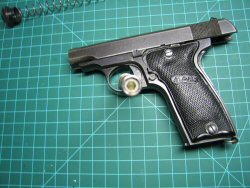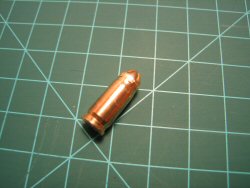IMPORTANT:
Proceed at your own risk. We're not responsible for you blowing yourself or your gun up.Blank Adapting the MAB-D and Browning 1910/1922
Date Written: 3/5/2008
Author: Chris Guska
Lets face it - the majority of the blank adapted pistols you see at reenactments are the common, easy to blank adapt P38's or 1911's or purpose made 8mm blank pistols. There were a tremendous number of .32 auto and .380 auto designs and variants in use by military officers and more so local police forces before the war and throughout the duration. The Browning / Fabrique Nationale 1910 / 1922 pistol was one of the most popular .32 auto's for police and military use in Europe during the 20's, 30's and 40's. This pistol and its subsequent variants are under displayed and under represented in the reenactment community. Maybe that will change now that I've done the leg work and got everyone that much closer to bustin some .32 auto blanks at events.
This article directly addresses the MAB model D. The MAB-D was a French made, enhanced copy of the Browning 1910/22. The blank adaption procedures and starting points should be the same for both guns.
Robb from Atlantic Wall Blanks hooked me up with some factory made, Fiocchi .32 ACP blanks to get things started. Based on our conversations, it sounds that very few people have attempted to blank adapt .32 autos for semi automatic fire. Robb hoped that I could get something working, and provide the community with some midpoints on set screw apertures.
I chose to work on the MAB-D rather than the 1910/22 since parts were cheaper and easier to find. Springfield Sporter had surplus, excellent condition barrels available for $20 as well as recoil springs for a few dollars. For pistols, I always get a spare barrel to turn into a dedicated blank firing barrel - they're easy enough to change and usually available for reasonable prices.
At first glance at the pistol - I thought this would be an easy job to blank adapt. The pistol is a straight blow back design, with the barrel locking directly into the frame with a series of locking lugs. Blank adapting turned out to be more problematic than I had anticipated.
I highly recommend that if you want to blank adapt your 1910/22 or MAB-D, you either have the machinist skills to be able to figure this out, or you can take it to somebody who knows what they're doing. If you've never cut threads or used a boring bar, this isn't for you.
Tools Needed:
Barrel Vise
3/8 NC Plug Tap
Tap Wrench
Cutting Fluid
#32 drill bit (.116)
#31 drill bit (.120)
IF YOU ARE USING JOE SWANSON MOVIE BLANKS -ASK HIM FOR THE CORRECT DRILL BIT SIZES. THESE ARE TOO SMALL.
3/16 boring barI threaded the barrel approx 5/8 inch deep for 3/8 Coarse set screws so that I could use my existing selection of set screws.
This is where I thought I'd be done, and ready to start testing aperture sizes. Unfortunately this is where the problems began. After loading a magazine and attempting to chamber a blank, the slide did not go into battery. The Slide was approx 3/16 inch from fully closing, such that the rim and groove were exposed past the breech. Better yet, the round would not extract and had to be removed from the chamber with a cleaning rod.
Upon inspection of the blank, it was clear that the "bullet crimp" of the round had engaged 1/8" of rifling and prevented the round from fully chambering. This is where I initially stopped.
I discussed the problem with Robb from Atlantic Wall Blanks, who revealed that the quality of the Fiocchi blanks was inconsistent, but the rounds could be individually resized and the problem eliminated.
Although I appreciate Robb's offer to resize every single factory made Fiocchi blank so that its within spec, I wouldn’t want him to sit and resize all the blanks for the life of the pistol.
My decision was to spend two minutes and modify the $20 barrel rather than add additional cost to the blanks which run $30 per hundred.The Fiocchi .32 auto blanks measured .309-.311 at the crimp, where the rifling had begun to engage. I bored the rifling out of the barrel approximately .300 in front of the shoulder with a boring bar. Single rounds now chamber and eject without issues.
I guesstimated that .156 would be a good starting point for the Fiocchi blanks based on powder load, barrel size and fudge factor. Better to start large than blow the thing up or lock it up.
The MAB-D Cycled fairly consistently (but not 100%) at .120 with some feeding issues. .113 was at the absolute smallest end that you should use - as the action was becoming violent. The final aperture size that I settled at was .116 which was in the butter zone - Yes, 3 or 4 thousandths can make a significant difference - take your time!
The final issue I had was feeding from a partially or full magazine. If the magazine is loaded to more than 4 rounds, the top round has a tendency to cant downward and fail to feed. The .32 auto cartridge is a semi rimmed round, in that you have to stagger/stack the rounds so that they will feed properly – without the rounds catching on one another.
90th IDPG Projects






